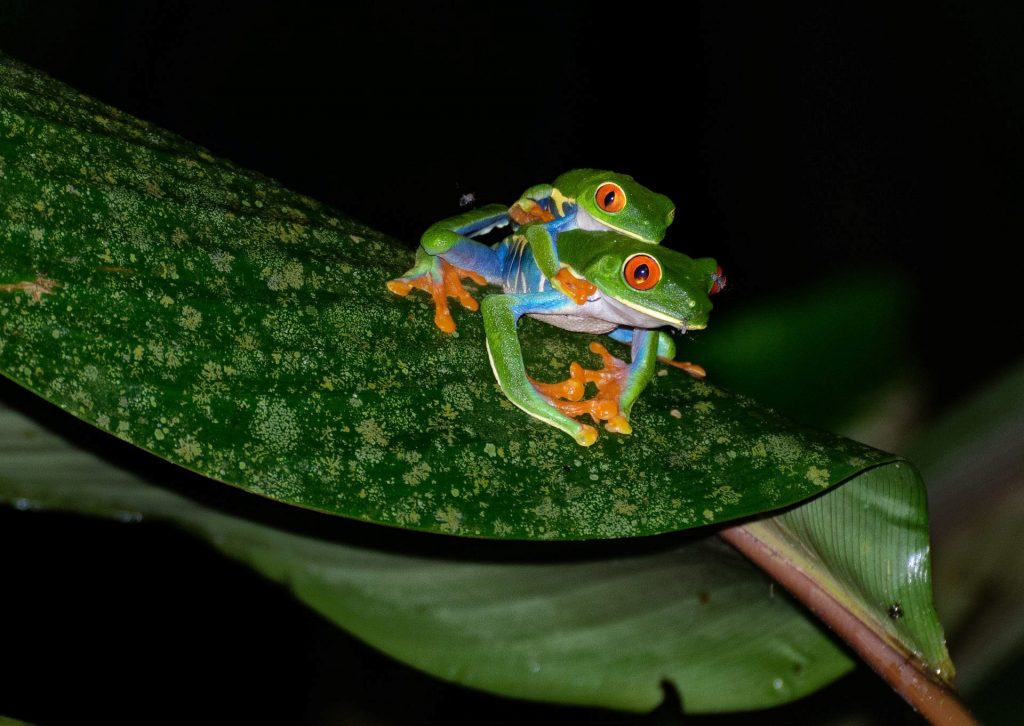14.4 Animal sex, from fish to birds
Most fish have external fertilization, but many have highly ritualized courtship routines that they use to choose a mate. The male will often perform courtship demonstrations of dancing, nest building or territory defense. (See examples of these with puffer fish, clown fish, and trumpet fish.) The male will follow the female, and once she deposits eggs on a surface, he will follow and deposit milt (the fish semen that contains sperm) over top.
A few fish (like guppies) have internal fertilization, in which the male inserts a specialized tubular fin into the female reproductive opening and deposits sperm into her reproductive tract.
Some fish are mouthbrooders, meaning that one fish puts the eggs in its mouth for incubation. Many cichlids are maternal mouth brooders. For these fish, the female lays the eggs and then picks them up in her mouth. Male fish will then encourage the female fish to open her mouth and will fertilize the eggs while in her mouth. For paternal mouth-brooding fish, the male puts the eggs in his mouth to incubate after he has fertilized them externally. Recall the discussion of anal-fin egg mimicry in Chapter 4…cichlid fish are fascinating!
Amphibians
Like fish, many amphibians have external fertilization. Many frogs and toads, for example, have a courting ritual in which the male frog rides on the female’s back and places specialized digits (essentially frog thumbs) on either side of the female in specialized, so-called nuptial pads. This grip helps keep the male frog from falling off as the female hops or swims around. The female eventually deposits her eggs and the male is in an ideal position to fertilize them.

A few salamanders perform external fertilization similar to that of frogs and toads, however most salamanders have internal fertilization. Male salamanders do not have penises to deposit sperm inside the female. Rather, they deposit an encased capsule of sperm and nutrients, a spermatophore, on the ground as part of a mating ritual. A female can pick up the spermatophore with her cloaca (a combined urinary and genital opening) and will use these sperm to fertilize her eggs internally. Most salamanders will then lay the fertilized eggs, however in a few species (such as the fire salamander) the eggs hatch inside the female and the female gives birth to larval salamanders.
Reptiles
Reptiles (e.g., lizards, turtles, snakes, and crocodiles) have internal fertilization. Reptiles have a great diversity of penises; some have a penis that is branched at the end (each end is called a hemipenis; reptiles only use one at a time), and some tortoises have umbrella-shaped penises. Some reptiles give birth to live young (called viviparity) and some lay eggs.
Birds
Most birds do not have penises, but achieve internal fertilization via cloacal contact (or “cloaca kiss”). In these birds, males and females contact their cloacas together, typically briefly, and transfer sperm to the female. Interestingly, water fowl such as ducks and geese have penises and use them for internal fertilization. Why would some birds use penises for fertilization, while others do not?
- Photo by Christophe Meneboeuf https://commons.wikimedia.org/wiki/File:RedEyesFrogs_Mating_(pixinn.net).jpg ↵

